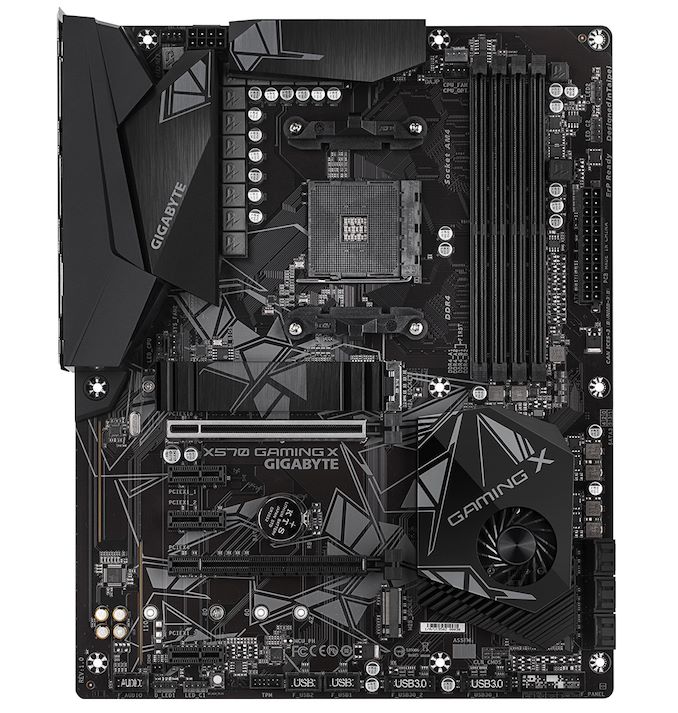The AMD X570 Motherboard Overview: Over 35+ Motherboards Analyzed
by Gavin Bonshor on July 9, 2019 8:00 AM ESTGIGABYTE X570 Gaming X
Currently at the bottom of GIGABYE's gaming-focused product stack is the X570 Gaming X. With a slightly lesser 10+2 power delivery when compared to the X570 Aorus Elite with a 12+2, the X570 Gaming X includes a cheaper Realtek ALC887 audio codec, a Realtek RTL8111H Gigabit NIC, and two PCIe 4.0 x4 M.2 slots. On the boards PCB itself is a very funky and unique black and grey theme with triangle shaped accents which extends over the PCB onto the heatsinks. The X570 chipset heatsink includes a cooling fan, while the board has four memory slots with support for DDR4-4000 memory with up to 128 GB.
On the lower half of the GIGABYTE X570 Gaming X is two full-length PCIe 4.0 slots which run at x16 and x16/x4. The top slot takes its lanes from the CPU, while the bottom full-length slot is locked at x4 from the X570 chipset, while there are also three PCIe 4.0 x1 slots; this means up to two-way AMD CrossFire multi-graphics card configurations can be used. For storage, the X570 Gaming X has two PCIe 4.0 x4 M.2 slots with the top slot coming with a heatsink, and a total of six SATA ports capable of support RAID 0, 1, and 10 arrays. The X570 Gaming X uses a 10+2 power delivery which is driven by an ISL69147 PWM controller running at 5+2 and uses a single 8-pin 12 V ATX CPU power input to delivery power to the processor.
On the rear panel is a relatively basic set of input and outputs with no USB 3.1 G2 connectivity to speak of. What actually is there in terms of USB support is four USB 3.1 G1 Type-A and two USB 2.0 ports. There is a separate pair of PS/2 inputs for legacy keyboard and mice. Finishing off the rear panel on the GIGABYTE X570 Gaming X is a single HDMI video output for users looking to run a compatible Ryzen APU, three 3.5 mm audio jacks that are driven by a Realtek ALC887 HD audio codec, and a Realtek RTL8111H Gigabit controlled Ethernet port.
The GIGABYTE X570 Gaming X is its gaming inspired, but surprisingly natural looking entry model onto the X570 chipset. With an MSRP of $169, it sits as one of the cheapest X570 models at the launch of the Ryzen 3000 processors, and with a wallet-friendly feature set with everything needed to make use of PCIe 4.0, it's a viable option for entry-level users. The only glaring issue is that there is no USB 3.1 G2 ports at all on the rear panel, and other models from other vendors at the same entry-level price point does include some.












225 Comments
View All Comments
isthisavailable - Wednesday, July 10, 2019 - link
The industry needs to make up its mind when it comes to USB C. Laptops are launching with only USB C and meanwhile $700 motherboards only have 1 USB C port and 8+ "outdated" USB A'sThe_Assimilator - Wednesday, July 10, 2019 - link
It's almost like there's a huge amount of peripherals with USB-A connectors that people who use PCs expect to continue to work when they upgrade! Isn't backwards compatibility a funny feature?Meanwhile, the only peripherals that laptops generally use are docks, hubs, and storage devices - all of which have USB-C versions out the wazoo.
naris - Wednesday, July 10, 2019 - link
Why are memory speeds and channels show & discussed when talking about chipsets when the memory controllers are in the CPUs? Memory controllers have not been in chipsets for many years now!halfflat - Wednesday, July 10, 2019 - link
ECC support can be hard to verify for mere mortals; collating (or even better, verifiying) ECC capability on these motherboards would be an extremely useful addition to the article.ishkatar - Wednesday, July 10, 2019 - link
Does any of the boards support Raid 5? I only see 0, 1 and 10.Zibi - Wednesday, July 10, 2019 - link
You don't want to use RAID 5 without proper RAID Controller with cache.That means dedicated card.
Actually from performance / security perspective RAID 10 is pretty OK.
The_Assimilator - Wednesday, July 10, 2019 - link
AMD dropped RAID-5 support upon introduction of the AM4 socket (remember, chipset functionality like RAID is now a CPU function). I don't have an issue with that, since -5 is a very uncommon use-case in consumer workloads and if you want to do -5 right, you really want a hardware RAID card with a BBU.But -5 is pretty much dead anyway due to ever-increasing drive sizes - the rebuild time on anything over 1TB is horrendous, what you really want in such a scenario is RAID-6, and no consumer motherboard every has or will support that.
And please don't tell me you're using RAID-5 for data integrity, because invisible corruption is a thing that I have experienced personally. If you want *actual* data integrity, use Windows Storage Spaces or RAID-10, and as a last resort RAID-6.
Arbie - Wednesday, July 10, 2019 - link
There must be something you left out of this roundup. Whatever it was, please go back and put it in, and next time get it right. Thanks.Korguz - Wednesday, July 10, 2019 - link
huh ????Gastec - Wednesday, July 10, 2019 - link
That $700 must be an error right, perhaps of judgement?